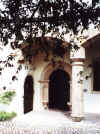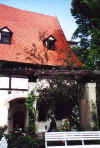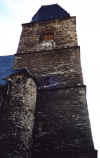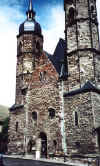|


| |
 |
Eisleben is the town where Martin Luther was born and
baptized (1483) and died (1546). Photo A is the entrance to the house in
which Luther was born. |
Facts and Photos
 The
Gothic house in which Margaret Luther gave birth to son Martin (photo B) on
November 10, 1483 was already marked with a plaque in the 16th century, shortly
after the Reformer's death. By the end of the 17th century, the house has been
turned into a school for the poor with a Luther memorial on the second story.
Wolfgang Hoffman writes, "The house in which Martin Luther was born thus
became one of the first museums of history on German soil" (70). The
Gothic house in which Margaret Luther gave birth to son Martin (photo B) on
November 10, 1483 was already marked with a plaque in the 16th century, shortly
after the Reformer's death. By the end of the 17th century, the house has been
turned into a school for the poor with a Luther memorial on the second story.
Wolfgang Hoffman writes, "The house in which Martin Luther was born thus
became one of the first museums of history on German soil" (70).
 Just
up the hill from the birth house is Saints Peter and Paul Church. On November
11, 1483, the feast of St. Martin of Tours and Luther's baptismal day, only the
west tower, constructed from 1447 to 1474, had been completed; here his baptism
took place (photo C). The cornerstone for the nave of the church was laid in
1486. Just
up the hill from the birth house is Saints Peter and Paul Church. On November
11, 1483, the feast of St. Martin of Tours and Luther's baptismal day, only the
west tower, constructed from 1447 to 1474, had been completed; here his baptism
took place (photo C). The cornerstone for the nave of the church was laid in
1486.
 Across
town and the market square are the house and church associated with Luther's
death. In St. Andrew's Church (photo D) Martin Luther preached his final sermon
on February 14, 1546, just days before his death. The pulpit from which he
preached has been preserved (unfortunately, my pictures of it didn't turn out
well). He was in Eisleben as the request of the Mansfeld counts, who wanted his
help to resolve a complicated dispute over inheritance rights. The famous native
son acquiesced, and during his third trip in five month to Eisleben after an
agreement had been reached, Luther fell ill. Across
town and the market square are the house and church associated with Luther's
death. In St. Andrew's Church (photo D) Martin Luther preached his final sermon
on February 14, 1546, just days before his death. The pulpit from which he
preached has been preserved (unfortunately, my pictures of it didn't turn out
well). He was in Eisleben as the request of the Mansfeld counts, who wanted his
help to resolve a complicated dispute over inheritance rights. The famous native
son acquiesced, and during his third trip in five month to Eisleben after an
agreement had been reached, Luther fell ill.
 Following
dinner on February 17, he complained of chest pains; a doctor was summoned and
he was given medication. After midnight he awoke in great distress. Asked by his
good friend, Justus Jonas, if he wanted to die standing firm on Christ and the
doctrine he had taught, Luther replied "Ja!" The house in which he
died, across from St. Andrew's, has undergone many changes and reconstruction
attempts. On display in the room adjoining that in which Luther died is a
genuine "Lutheran relic"–the black silk pall used to cover Luther's
body. Miriam Carter and I spent a quiet moment contemplating it (photo E). Following
dinner on February 17, he complained of chest pains; a doctor was summoned and
he was given medication. After midnight he awoke in great distress. Asked by his
good friend, Justus Jonas, if he wanted to die standing firm on Christ and the
doctrine he had taught, Luther replied "Ja!" The house in which he
died, across from St. Andrew's, has undergone many changes and reconstruction
attempts. On display in the room adjoining that in which Luther died is a
genuine "Lutheran relic"–the black silk pall used to cover Luther's
body. Miriam Carter and I spent a quiet moment contemplating it (photo E).
Reflections
A curious thing happened to my parents in Eisleben. We had visited Luther's
birth house, but the baptismal church wasn't open, so we headed across town, had
lunch, and then saw St. Andrew's and the death house. That was enough walking
for Dad. While Miriam, Richard, and I hoofed back to see the baptismal church,
Mom and Dad waited in the town square near St. Andrew's. As they sat on the
square eating ice cream, a man approached them. Between his limited English and
Mom's limited German, they learned that he had been a prisoner of war in
Kentucky during World War II. He said he didn't want to return to Germany after
the war, but the prisoners were given no choice. Living in East Germany for
decades, I'm sure he rarely had the opportunity to speak to two tourist of his
generation on their own–even now, 10 years after reunification of Germany, it
must be a rare sight to see a couple of America senior citizens sitting alone in
a small town in the eastern Germany. He didn't miss the opportunity! What's even
more amazing is that Mom and Dad had a similar experience in Erfurt, as they
waited for the three of us on the market square. Both men seemed very eager to
speak to Mom and Dad and expressed the wish that they could have stayed in the
United States; perhaps after 50 years under communist rule, they looked back on
their experiences as World War II prisoners of war as less oppressive than life
was in the former East Germany.�
|
